AUDI S3 2015 Owners Manual
Manufacturer: AUDI, Model Year: 2015, Model line: S3, Model: AUDI S3 2015Pages: 310, PDF Size: 76.15 MB
Page 231 of 310
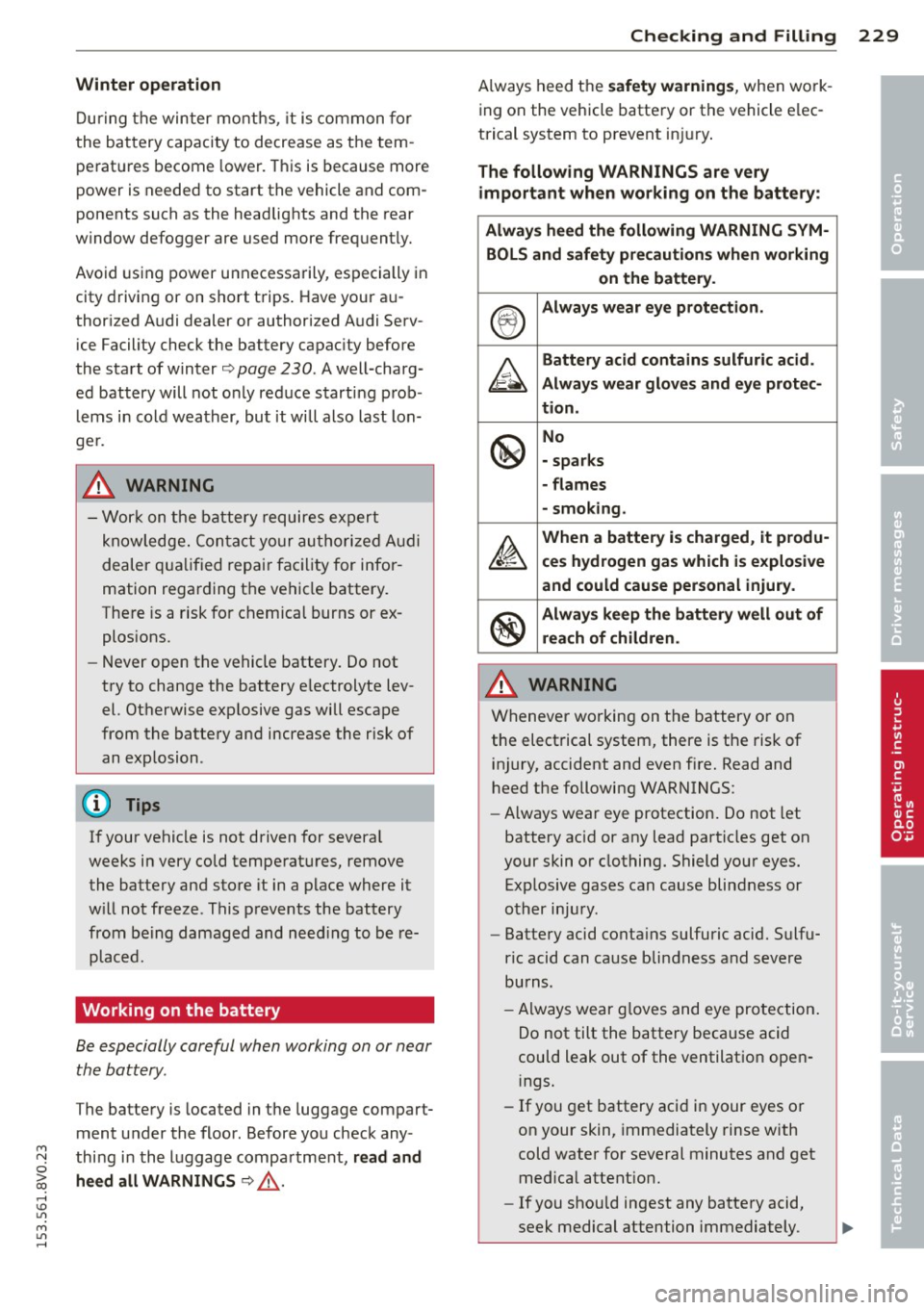
Winter operati on
During the winter months, it is common for
the battery capacity to decrease as the tem
peratures become lower. This is because more
pow er is n eeded to start the vehicle and com
ponents such as the headlights and the rear
window defogger are used more frequently.
Avoid using power unnecessarily, especially in
city driving or on short trips . Have your a u
thorized Audi dealer or authorized Audi Serv
ice Facility check the battery capac ity before
the start of winter ¢
page 230 . A well-charg
ed battery will not only reduce starting prob
l ems in cold weather, but it wi ll also last lon
ge r.
A WARNING
- Wor k on the battery requires expert
knowledge. Con tact your au thori zed Audi
dealer q ua lified repai r fac ility for infor
mation regarding the vehicle battery.
The re is a risk for chemical burns or ex
plos ions.
- Never open the vehicle battery. Do not
try to change the battery e lectrolyte lev
el. Otherwise explosive gas will escape
from the battery and increase the risk of an exp losion .
@ Tips
If your vehicle is not driven for severa l
weeks in very cold temperatures, remove
the battery and store it in a place where it
w ill no t freeze . This prevents the battery
from being damaged and need ing to be re
placed.
Working on the battery
Be especially careful when working on or near the battery .
The battery is located in the lugg age compart
ment under the floor. Before you check any -
"' N thing in the luggage compartment, read and 0
iii heed all WARNINGS ¢ _&.
Checking and Fillin g 229
Always heed the safety warning s, when work
ing on the vehicle battery or the vehicle e lec
trical system to prevent in jury.
The following WARNINGS are very
important wh en working on the batte ry :
Alway s heed th e following WARNING SYM -
BOLS and safety pre caution s when working
on the battery .
®
Always wear eye p rotection .
A
Battery acid contain s sulfuric acid .
Always wear glov es and eye protec -
tion .
@
No
- sparks
- flames
- smoking .
~
When a battery is charged, it produ-
ce s hydrogen g as wh ich i s ex plo sive
and could c au se per sonal injury .
®
Always keep the battery well out of
re ac h of children .
A WARNING
Whenever working on the battery o r on
the elect rical system, there is the risk of
injury, accident and even fire. Read and
heed the following WARNINGS :
- Always wear eye protection. Do not let
-
battery ac id or any lead particles get on
your skin or clothing. Shield your eyes.
Exp losive gases can cause blindness or
other inju ry.
- Battery acid conta ins sulfuric acid. Sulfu
ric acid can cause blindness and severe
bu rns.
- Always wear g loves and eye protection.
Do not tilt the battery because acid
could leak out of the ventilat ion open
i ngs.
- If you get battery aci d in your eyes or
on your skin, immediately rinse with
cold water for several minutes and get med ica l attent ion.
- If you should ingest any battery acid,
seek medical attention immediately . •
•
•
Page 232 of 310
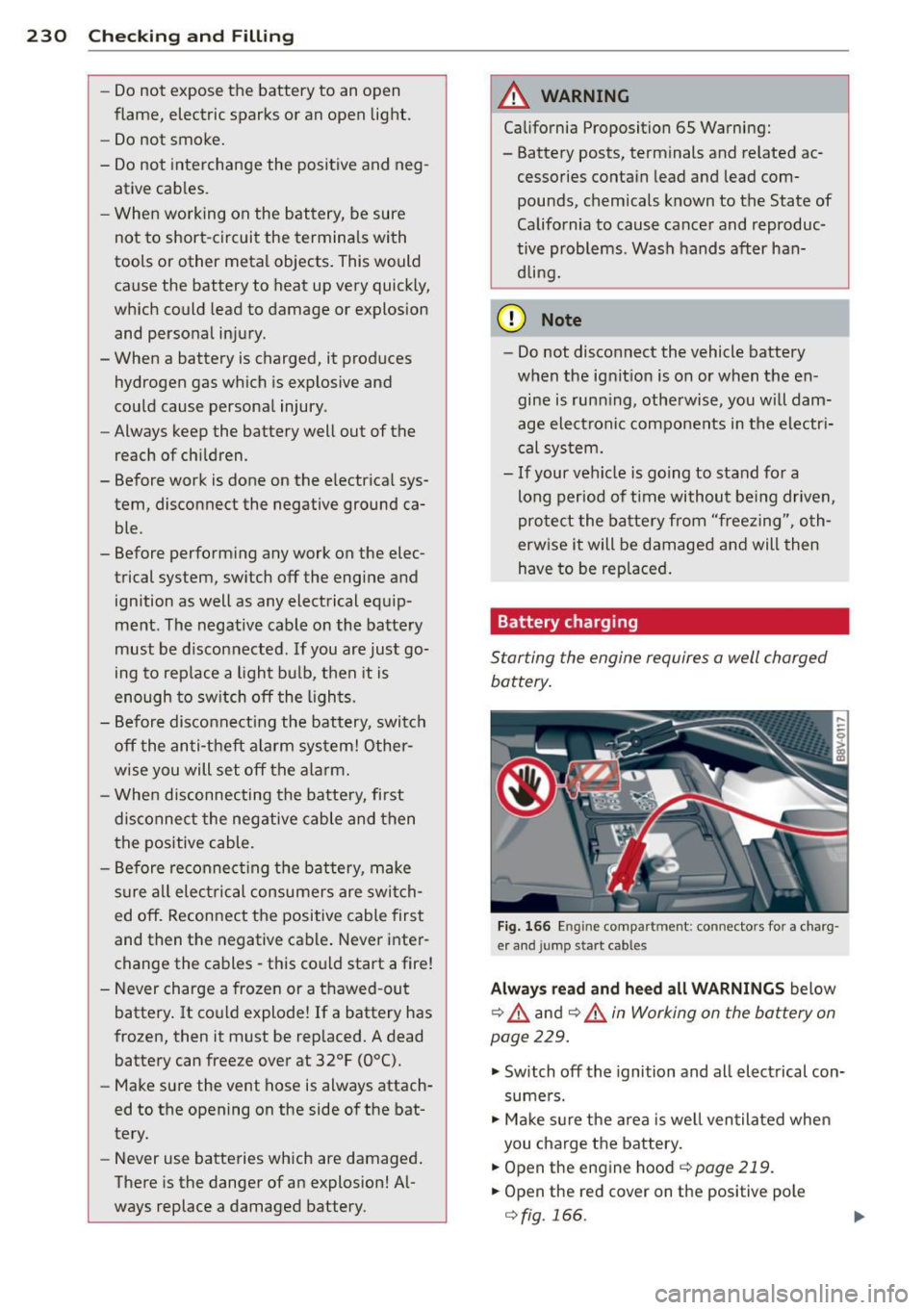
230 Checking and Filling
-Do not expose the battery to an open
flame, electric sparks or an open light.
- Do not smoke.
- Do not interchange the positive and neg-
ative cables.
- When working on the battery, be sure
not to short-circuit the terminals with
tools or other metal objects. This would
cause the battery to heat up very quickly,
which could lead to damage or explosion
and personal injury.
- When a battery is charged, it produces
hydrogen gas which is explosive and
could cause personal injury.
- Always keep the battery well out of the
reach of children.
- Before work is done on the electrical sys
tem, disconnect the negative ground ca ble.
- Before performing any work on the elec
trical system, switch off the engine and ignition as well as any electrical equip
ment . The negative cable on the battery
must be disconnected . If you are just go
ing to replace a light bulb, then it is
enough to switch off the lights.
- Before disconnecting the battery, switch
off the anti-theft alarm system! Other
wise you will set off the alarm.
- When disconnecting the battery, first
disconnect the negative cable and then
the positive cable .
- Before reconnecting the battery, make
sure all electrical consumers are switch
ed off. Reconnect the positive cable first
and then the negative cable. Never inter
change the cables -this could start a fire!
- Never charge a frozen or a thawed-out
battery. It could explode! If a battery has
frozen, then it must be replaced. A dead battery can free ze over at 32°F (O°C).
- Make sure the vent hose is always attach
ed to the opening on the side of the bat
tery.
- Never use batteries which are damaged.
There is the danger of an explosion! Al
ways replace a damaged battery . A WARNING
-California Proposition 65 Warning:
- Battery posts, terminals and related ac
cessories contain lead and lead com
pounds, chemicals known to the State of
California to cause cancer and reproduc
tive problems . Wash hands after han
dling.
(D Note
- Do not disconnect the vehicle battery
when the ignition is on or when the en
gine is running, otherwise, you will dam
age electronic components in the electri
cal system.
- If your vehicle is going to stand for a
long period of time without being driven,
protect the battery from "freezing", oth
erwise it will be damaged and will then
have to be replaced.
Battery charging
Starting the engine requires a well charged
battery.
Fig. 166 E ngin e compart men t: co nnecto rs for a charg
e r and jump st art ca bles
Always read and heed all WARNINGS below
~ .&_ and q .&_ in Working on the battery on
page 229.
~ Switch off the ignition and all electrical con
sumers.
~ Make sure the area is well ventilated when
you charge the battery.
~ Open the engine hood q page 219 .
~ Open the red cover on the positive pole
qfig. 166 .
Page 233 of 310
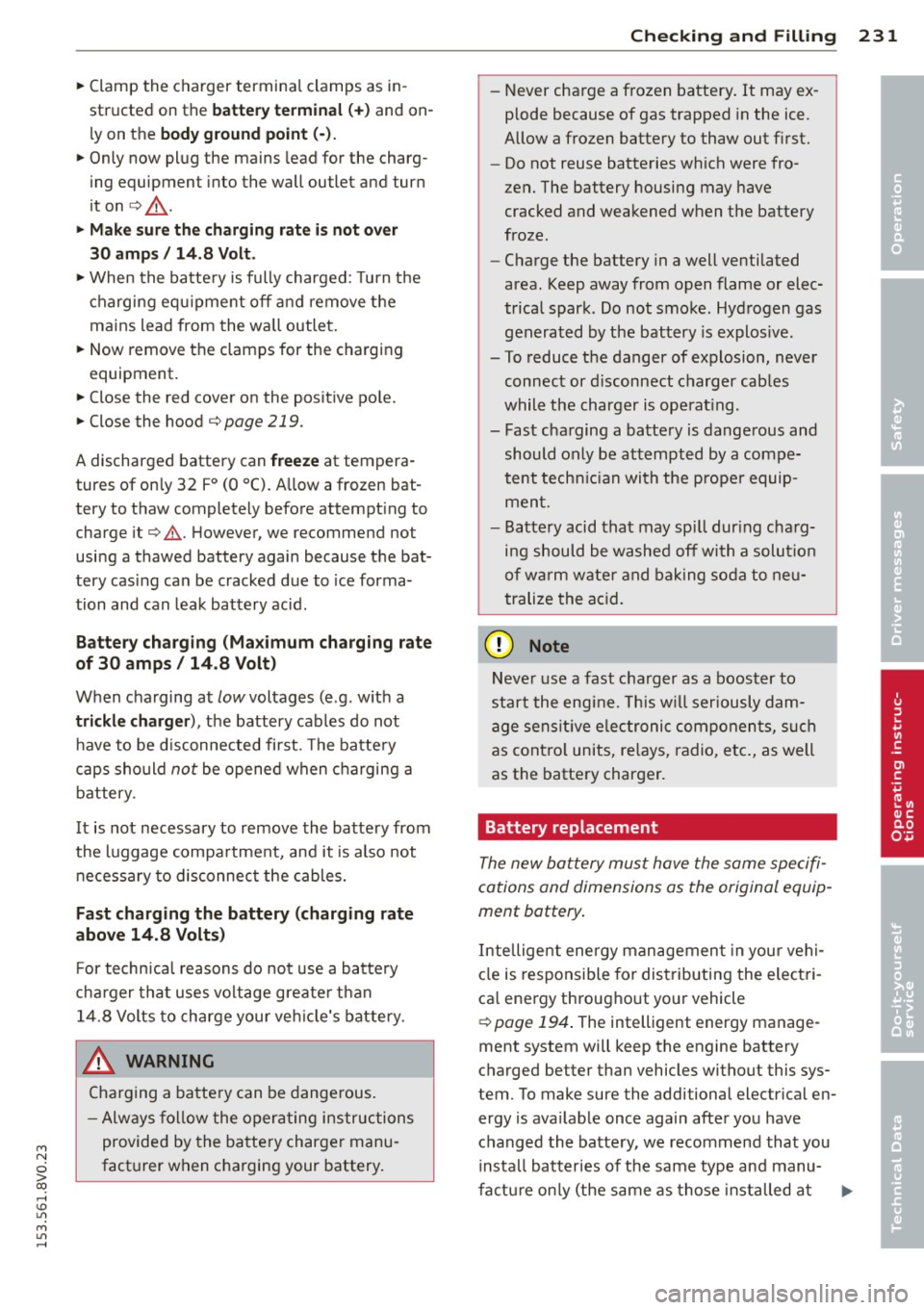
M N
0 > co ,...., \!) ..,.,
M ..,., ,....,
~ Clamp the charger terminal clamps as in
structed on the
b atter y ter min al (+ ) and on
ly on the
body ground point (·).
~ Only now plug the mains lead for the charg
ing equipment into the wall outlet and turn
it on
c:> ,.&. .
~ Mak e sure the charging rate i s not o ver
30 amp s / 14.8 Volt .
~ When the batte ry is fully charged: Turn the
c harging equ ipment off a nd remove the
mains lead from the wall outle t.
~ Now remove the clamps for the charging
equipment.
~ Close the red cover on the positive po le.
~ Close the hood <=> page 219.
A discharged battery can freeze at tempera
tures of on ly 32 F
0 (0 °C). A llow a frozen bat
tery to thaw completely before attempt ing to
charge it
c:> &. . However, we recommend not
using a thawed battery again because the bat
tery cas ing can be cracked due to ice forma
tion and can leak battery acid.
B atter y ch arging (Ma ximum charging rate
of
30 amps / 14.8 Volt)
When cha rging at low voltages (e .g. w ith a
tric kle charger ), the battery cables do not
have to be d isconnected first. The batte ry
caps sho uld
not be opened when charging a
battery .
It is not necessary to remove the batte ry from
the luggage compa rtment, and it is also not
necessa ry to disconnec t the cables.
Fa st charging the b attery (charging rate
above
14.8 Volts )
For technica l reasons do not use a battery
charger that uses voltage g reate r than
14.8 Volts to charge your veh icle's battery.
WARNING
Charging a battery can be dangerous.
- Always fo llow the oper ating instructions
provided by the battery charge r manu
fact urer when charging your battery.
Checking and Fillin g 231
-Never charge a frozen battery. It may ex
plode because of gas trapped in the ice .
Allow a frozen battery to thaw out first.
- Do not reuse batteries wh ich were fro
zen. The battery housing may have
cracked and weakened when the battery
froze.
- Charge the battery in a well ventilated
area. Keep away from open flame or elec
trical spark. Do not smoke. Hydrogen gas
generated by the battery is explos ive.
- To reduce the danger of explosion, never connect or d isconnect charger cab les
while the charger is ope rat ing.
- Fast charging a batte ry is dangerous and
should only be attempted by a compe
tent techn ic ian with the prope r equip
ment.
- Battery acid that may spi ll dur ing cha rg
ing should be washed off wi th a solut io n
of wa rm w ater and baking soda to neu
trali ze the ac id.
(D Note
Neve r use a fast cha rger as a boost er to
star t the engine. This w ill ser iously dam
age sens it ive e lectronic componen ts, su ch
as cont ro l units, re lays, radio, etc., as well
as the battery charger.
Battery replacement
The new battery must have the same specifi
cations and dimensions as the original equip
ment battery.
Inte lligent energy management in your vehi
cl e is responsible for dist ributing the elect ri
ca l energy throughout yo ur vehicle
<=> page 194 . The intelligent energy manage
ment system will keep the engine battery
charged better than vehicles without this sys
tem . To make sure the additional electrical en
ergy is ava ilab le once again after you have
changed the batte ry, we recommend that you
insta ll batteries of the same type and manu-
factu re on ly (the same as those installed at
IJI,,
•
•
•
Page 234 of 310
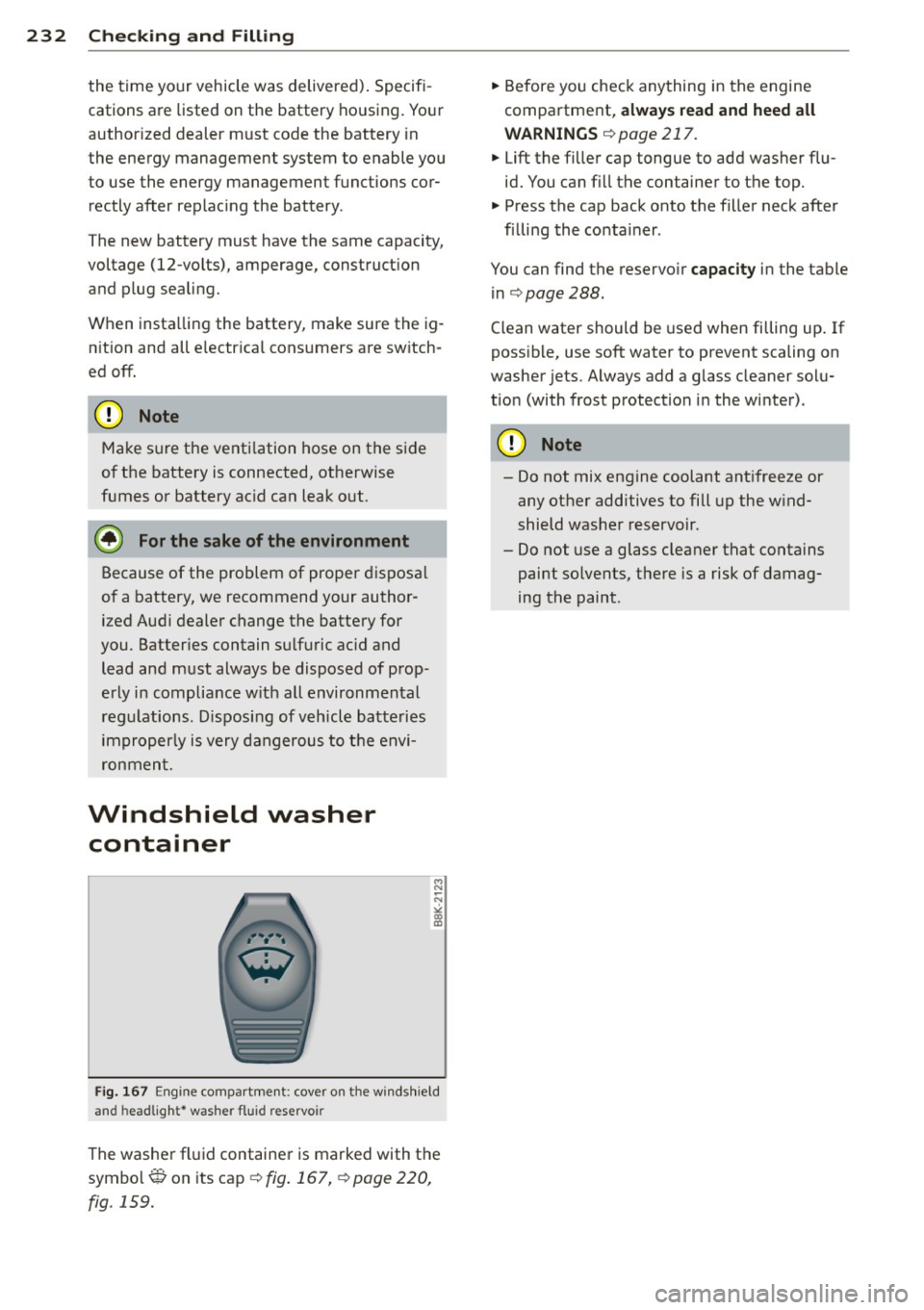
232 Check ing and F illin g
the time your vehicle was delivered) . Specifi
cations are listed on the battery housing. Yo ur
author ized dealer must code the battery in
the energy management system to enable you
to use the energy management functions cor rectly after replac ing the battery .
The new battery must have the same capacity,
voltage (12-volts), amperage, construct ion
and plug sealing.
When insta lling the battery, make sure the ig
n ition and all e lectr ica l consumers are sw itch
ed off.
Make sure the venti lation hose on the side
of the battery is connected, otherwise
fumes or battery ac id can leak out.
@ For the sake of the environment
Because of the problem of proper disposa l
of a battery, we recommend your author
ized Audi dealer change the battery for
you. Batter ies contain su lfuric ac id and
lead and must always be disposed of prop
erly i n compliance w ith all environmental
regu lations . D ispos ing of vehicle batteries
improper ly is very dangerous to t he envi
ronmen t.
Windshield washer
container
M N ~ N
"' co
co
F ig . 167 Eng ine compa rt m ent: cove r on the w indshi eld
an d h ead ligh t* washer f lu id re servo ir
The washer f luid container is marked with the
symbo l won its cap ¢
fig. 167, ¢ page 220,
fig. 159.
.. Before you check anything in the engine
compartment,
always read and heed all
WARNINGS ¢ page 217 .
.. Lift the fi ller cap tongue to add washer flu
id. You can f ill the container to the top.
.. Press the cap back onto the filler neck afte r
filling the conta iner .
You can find the reservo ir
capacit y in the table
in c:>
page 288.
Clean water should be used when filling up . If
poss ib le, use soft water to prevent scaling on
washer jets . Always add a g lass cleaner solu
t ion (with frost protection in the w inter) .
(D Note
- Do not mix engine coolant ant ifreeze or
any other additives to fill up the w ind
shield washer reservoir .
- Do not use a glass cleaner that contains
paint so lvents, there is a risk of damag
ing the paint.
Page 235 of 310
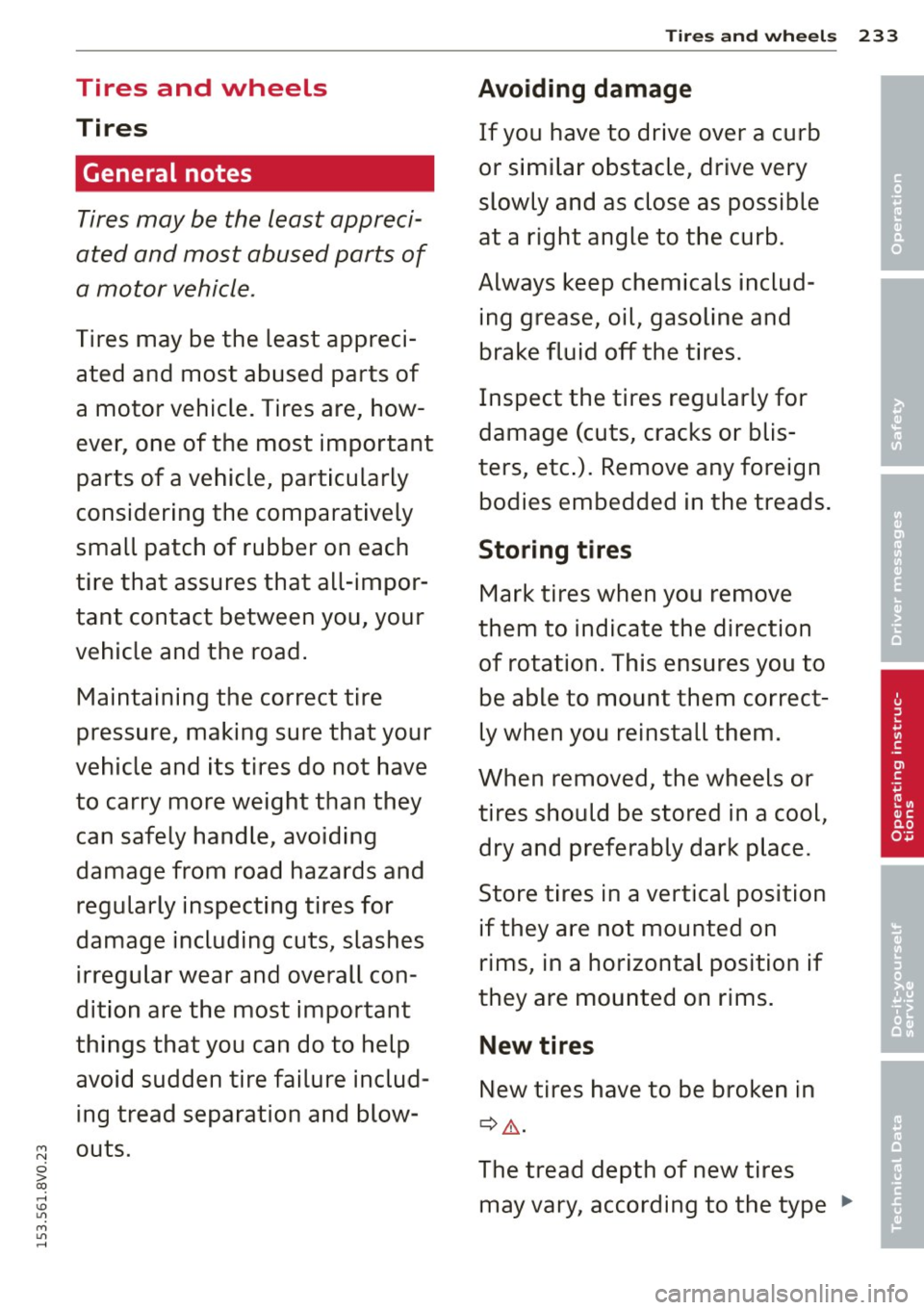
Tires and wheels
Tires
General notes
Tires may be the least appreci
ated and most abused parts of
a motor vehicle .
Tires may be the least appreci
ated and most abused parts of
a motor vehicle. Tires are, how
ever, one of the most important
parts of a vehicle, particularly
considering the comparatively
small patch of rubber on each
tire that assures that all-impor
tant contact between you, your
vehicle and the road.
Maintaining the correct tire
pressure, making sure that your
vehicle and its tires do not have
to carry more weight than they can safely handle, avoiding
damage from road hazards and
regularly inspecting tires for
damage including cuts, slashes
irregular wear and overall con
dition are the most important
things that you can do to help avoid sudden tire failure includ
ing tread separation and blow-
~ outs.
0 > co ,...., \!) 1.1'1
M 1.1'1 ,....,
Tires and wheels 233
Avoiding damage
If you have to drive over a curb
or similar obstacle, drive very
slowly and as close as possible
at a right angle to the curb.
Always keep chemicals includ ing grease, oil, gasoline and
brake fluid off the tires.
Inspect the tires regularly for
damage (cuts, cracks or blis
ters, etc.). Remove any foreign
bodies embedded in the treads.
Storing tires
Mark tires when you remove
them to indicate the direction
of rotation. This ensures you to be able to mount them correct
ly when you reinstall them.
When removed, the wheels or
tires should be stored in a cool, dry and preferably dark place.
Store tires in a vertical position if they are not mounted on
rims, in a horizontal position if
they are mounted on rims.
New tires
New tires have to be broken in
¢ _&. .
The tread depth of new tires
may vary , according to the type .,.
' •
•
' •
Page 236 of 310
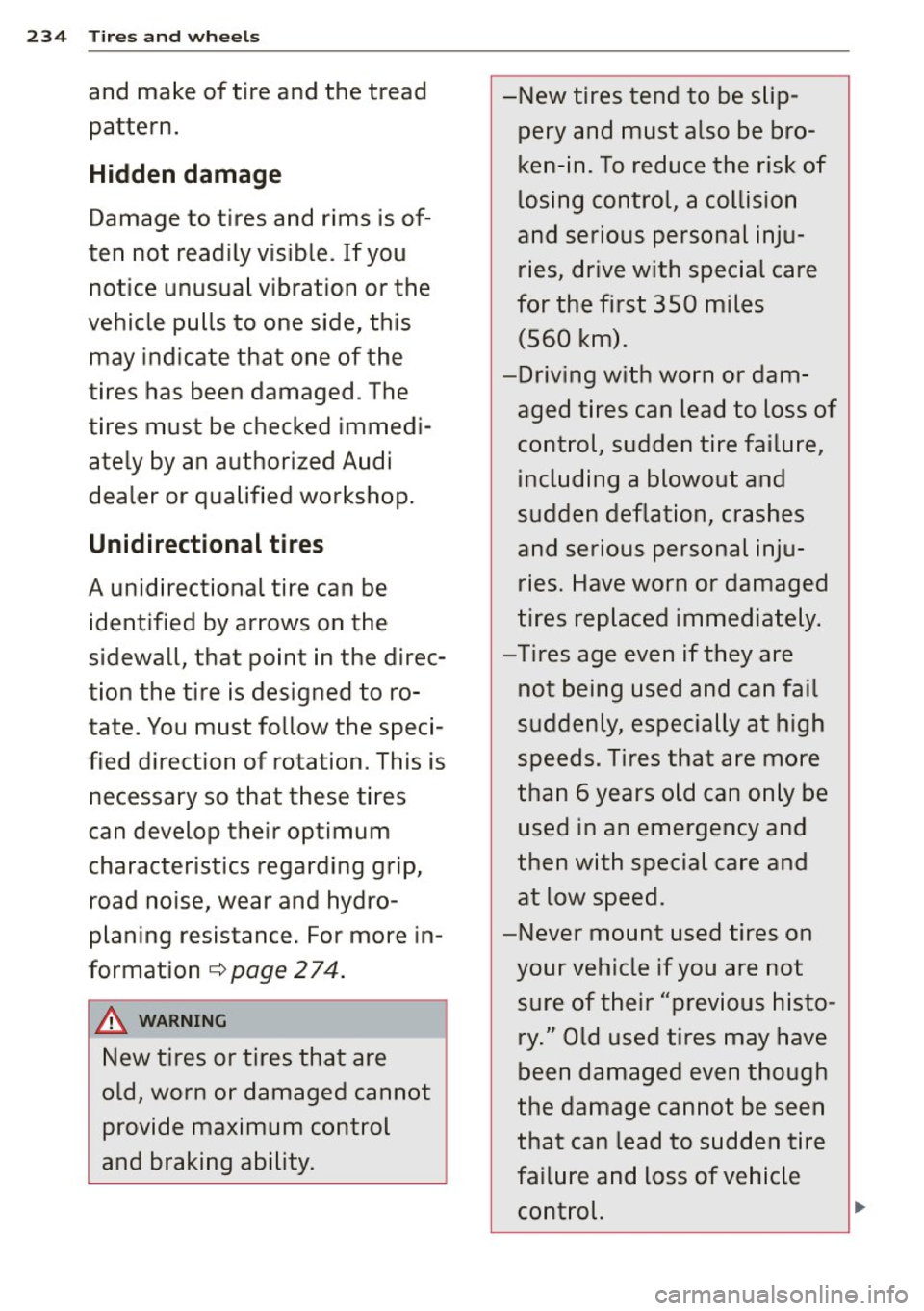
234 Tires and wheels
and make of tire and the tread
pattern.
Hidden damage
Damage to tires and rims is of
ten not readily visible. If you
notice unusual vibration or the
vehicle pulls to one side, this may indicate that one of the
tires has been damaged . The
tires must be checked immedi
ately by an authorized Audi
dealer or qualified workshop.
Unidirectional tires
A unidirectional tire can be identified by arrows on the
sidewall, that point in the direc
tion the tire is designed to ro
tate. You must follow the speci
fied direction of rotation. This is
necessary so that these tires
can develop their optimum
characteristics regarding grip,
road noise, wear and hydro
planing resistance. For more in
formation
¢page 274.
&_ WARNING
New tires or tires that are
old, worn or damaged cannot provide maximum control
and braking ability. -New
tires tend to be slip
pery and must also be bro
ken-in. To reduce the risk of
losing control, a collision
and serious personal inju
ries, drive with special care
for the first 350 miles (560 km).
-Driving with worn or dam aged tires can lead to loss of
control, sudden tire failure,
including a blowout and
sudden deflation, crashes
and serious personal injuries. Have worn or damaged
tires replaced immediately.
-Tires age even if they are
not being used and can fail
suddenly, especially at high
speeds. Tires that are more
than 6 years old can only be
used in an emergency and
then with special care and at low speed.
-Never mount used tires on your vehicle if you are not sure of their "previous histo
ry." Old used tires may have
been damaged even though
the damage cannot be seen
that can lead to sudden tire
failure and loss of vehicle
control.
...
Page 237 of 310
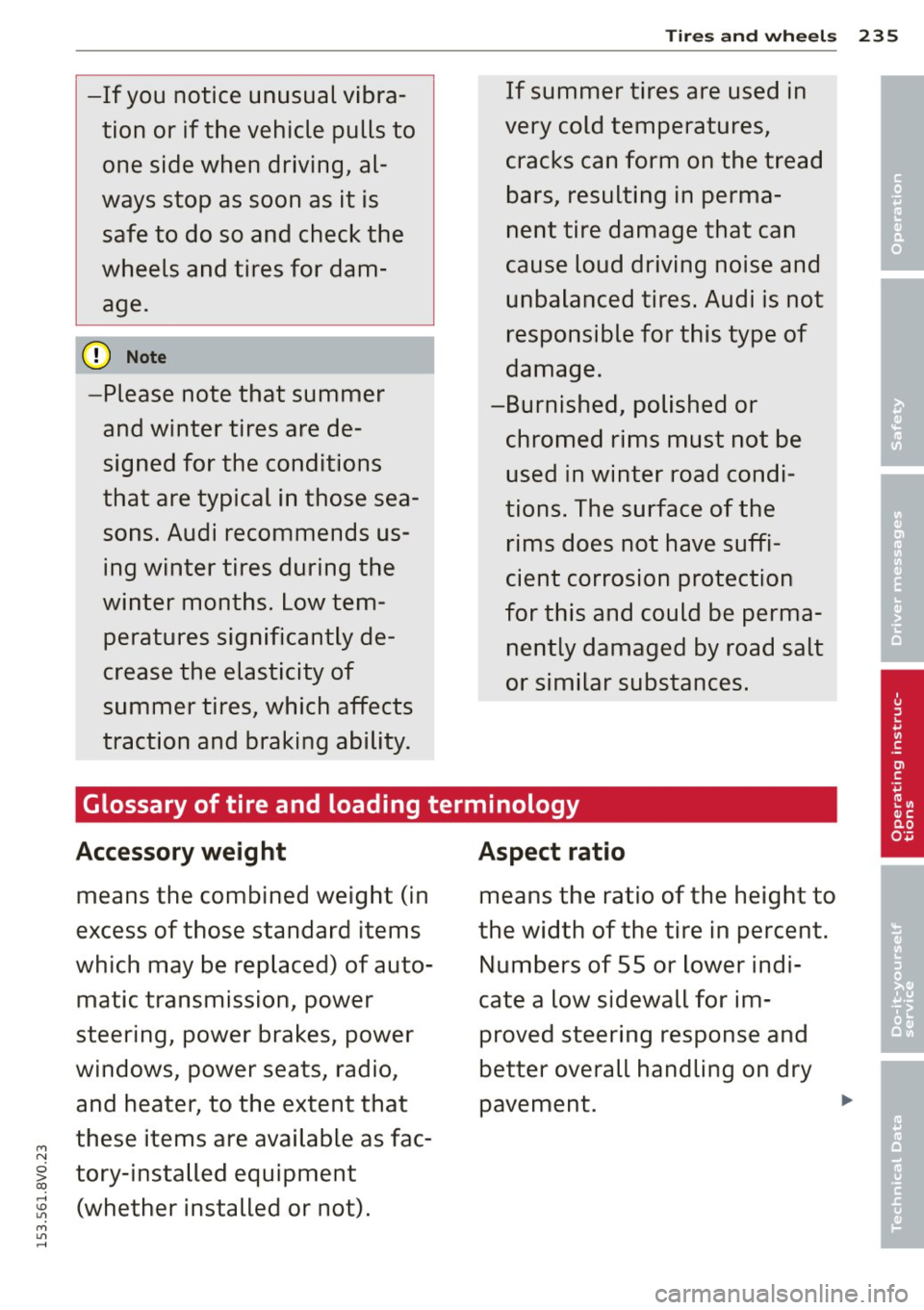
M N
0 > co ...... \!) 1.1'1
M 1.1'1 ......
-If you notice unusual vibration or if the vehicle pulls to one side when driving, al
ways stop as soon as it is safe to do so and check the
wheels and tires for dam age.
(D Note
-Please note that summer and winter tires are de
signed for the conditions
that are typical in those sea
sons. Audi recommends using winter tires during the
winter months. Low tem peratures significantly de
crease the elasticity of
summer tires, which affects
traction and braking ability.
Tires and wheels 235
If summer tires are used in
very cold temperatures, cracks can form on the tread bars, resulting in perma
nent tire damage that can
cause loud driving noise and unbalanced tires. Audi is not
responsible for this type of
damage.
-Burnished, polished or chromed rims must not be used in winter road condi
tions. The surface of the
rims does not have suffi
cient corrosion protection
for this and could be perma
nently damaged by road salt
or similar substances.
' •
•
Glossary of tire and loading terminology
Accessory weight
means the combined weight (in
excess of those standard items
which may be replaced) of auto matic transmission, power
steering, power brakes, power
windows, power seats, radio, and heater, to the extent that
these items are available as fac
tory-installed equipment (whether installed or not).
Aspect ratio
means the ratio of the height to
the width of the tire in percent. Numbers of 55 or lower indi
cate a low sidewall for im proved steering response and
better overall handling on dry
pavement.
' •
Page 238 of 310
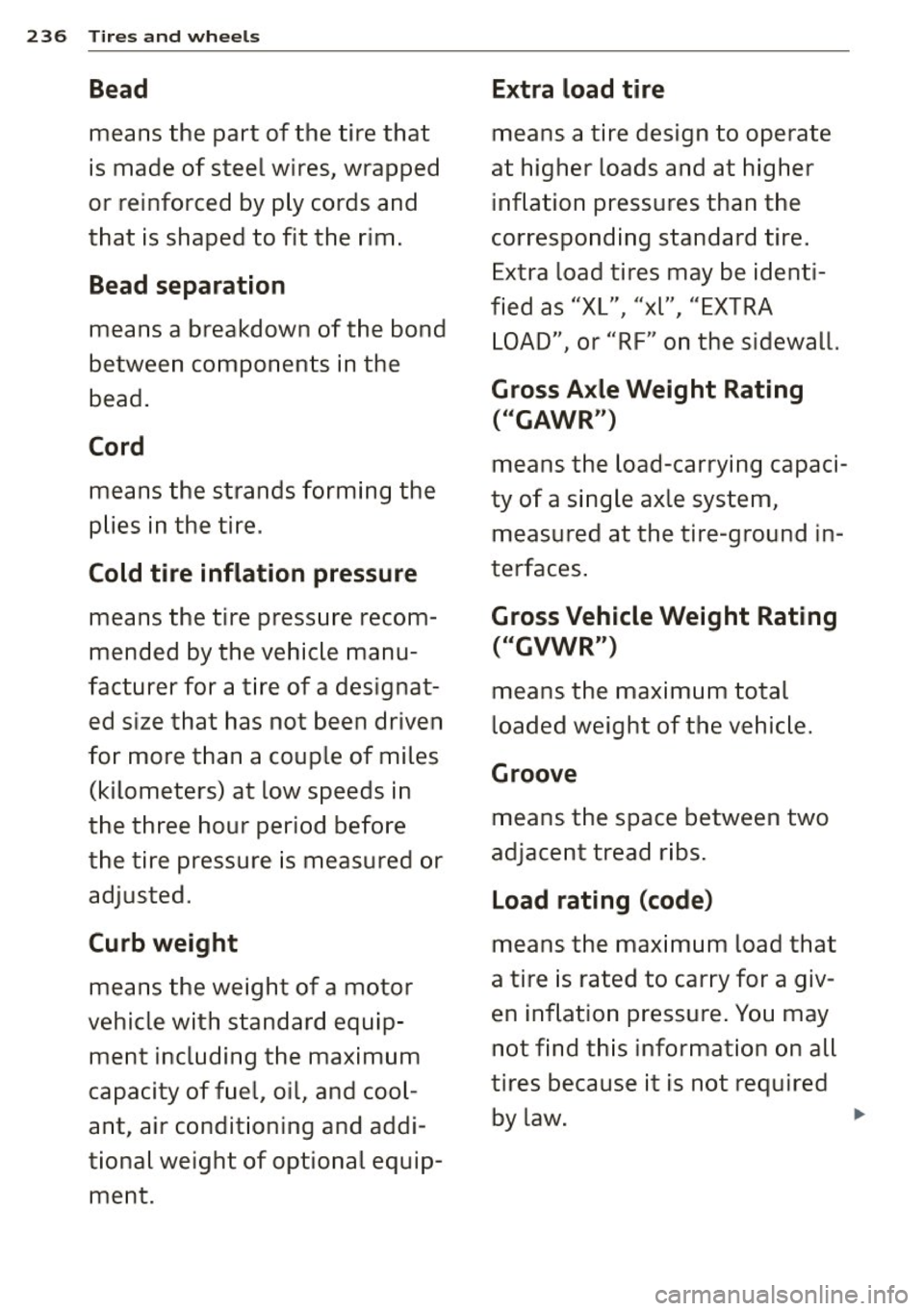
236 Tires a nd whee ls
Bead Extra load tire
means the part of the tire that means a tire design to operate
is made of steel wires, wrapped at higher loads and at higher
or reinforced by p ly cords and inflation pressures than the
that is shaped to fit the rim . corresponding standard tire .
Bead separation Extra load tires may be identi-
fied as "XL", "xl", " EXTRA
means a breakdown of the bond LOAD", or "RF" on the sidewall.
between components in the
bead .
Gross A xle Weight Rating
(" GAWR ")
Cord
means the load-carrying capaci-
means the strands forming the ty of a single axle system,
p lies in the tire .
measured at the tire-ground in-
Cold tire inflation pressure terfaces.
means the tire pressure recom-
Gross Vehicle Weight Rating
mended by the vehicle manu-( "GVWR ")
facturer for a t ire of a designat-
means the maximum total
ed size that has not been driven loaded weight of the vehicle.
for more than a couple of miles
Groove
(kilometers) at low speeds in
the three hour period before means the space between two
the tire pressure is measured or adjacent tread ribs.
adjusted.
Load rating (code )
Curb weight
means the max imum load that
means the weight of a motor a tire
is rated to carry for a giv-
vehicle with standard equip -en inflation pressure
. You may
ment including the maximum not find th
is information on all
capacity of fuel, oil, and cool- tires because it is not required
ant, air condit ioning and addi- by law.
...
tional weight of optional equip-
ment.
Page 239 of 310
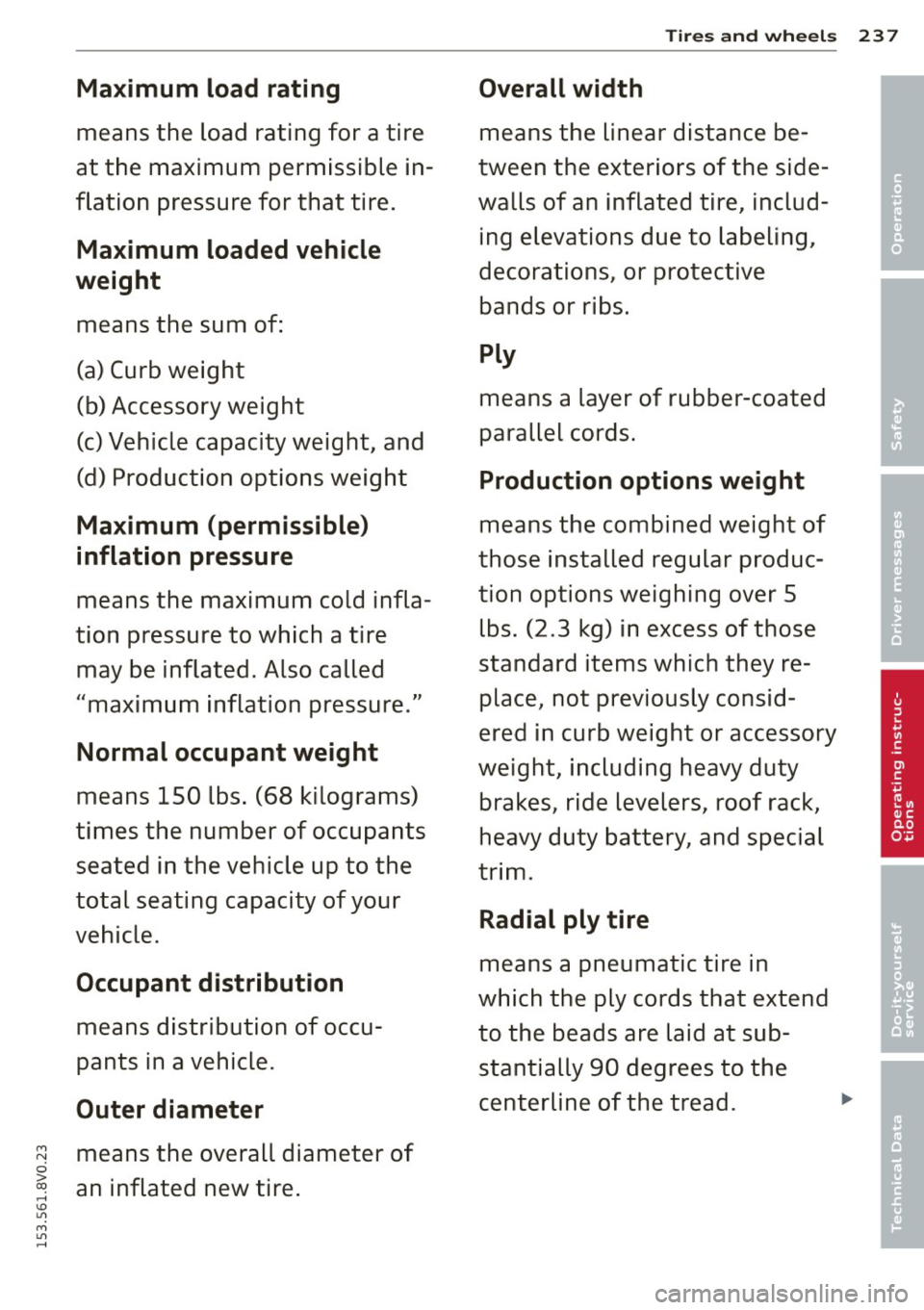
M N
0 > co ,...., \!) 1.1'1
M 1.1'1 ,....,
Maximum load rating
means the load rating for a tire
at the maximum permissible in
flation pressure for that tire.
Maximum loaded vehicle
weight
means the sum of:
(a) Curb weight
(b) Accessory weight
(c) Vehicle capacity weight, and
(d) Production options weight
Maximum (permissible)
inflation pressure
means the maximum cold infla
tion pressure to which a tire
may be inflated. Also called
"maximum inflation pressure."
Normal occupant weight
means 150 lbs. (68 kilograms)
times the number of occupants seated in the vehicle up to the
total seating capacity of your
vehicle.
Occupant distribution
means distribution of occu pants in a vehicle.
Outer diameter
means the overall diameter of
an inflated new tire.
Tires and wheels 237
Overall width
means the linear distance be
tween the exteriors of the side
walls of an inflated tire, includ ing elevations due to labeling,
decorations, or protective bands or ribs.
Ply
means a layer of rubber-coated
parallel cords.
Production options weight
means the combined weight of
those installed regular produc
tion options weighing over 5 lbs. (2 . 3 kg) in excess of those
standard items which they re place, not previously consid
ered in curb weight or accessory
weight, including heavy duty
brakes, ride levelers, roof rack,
heavy duty battery, and special
trim.
Radial ply tire
means a pneumatic tire in
which the ply cords that extend
to the beads are laid at sub stantially 90 degrees to the
centerline of the tread.
' •
•
' •
Page 240 of 310
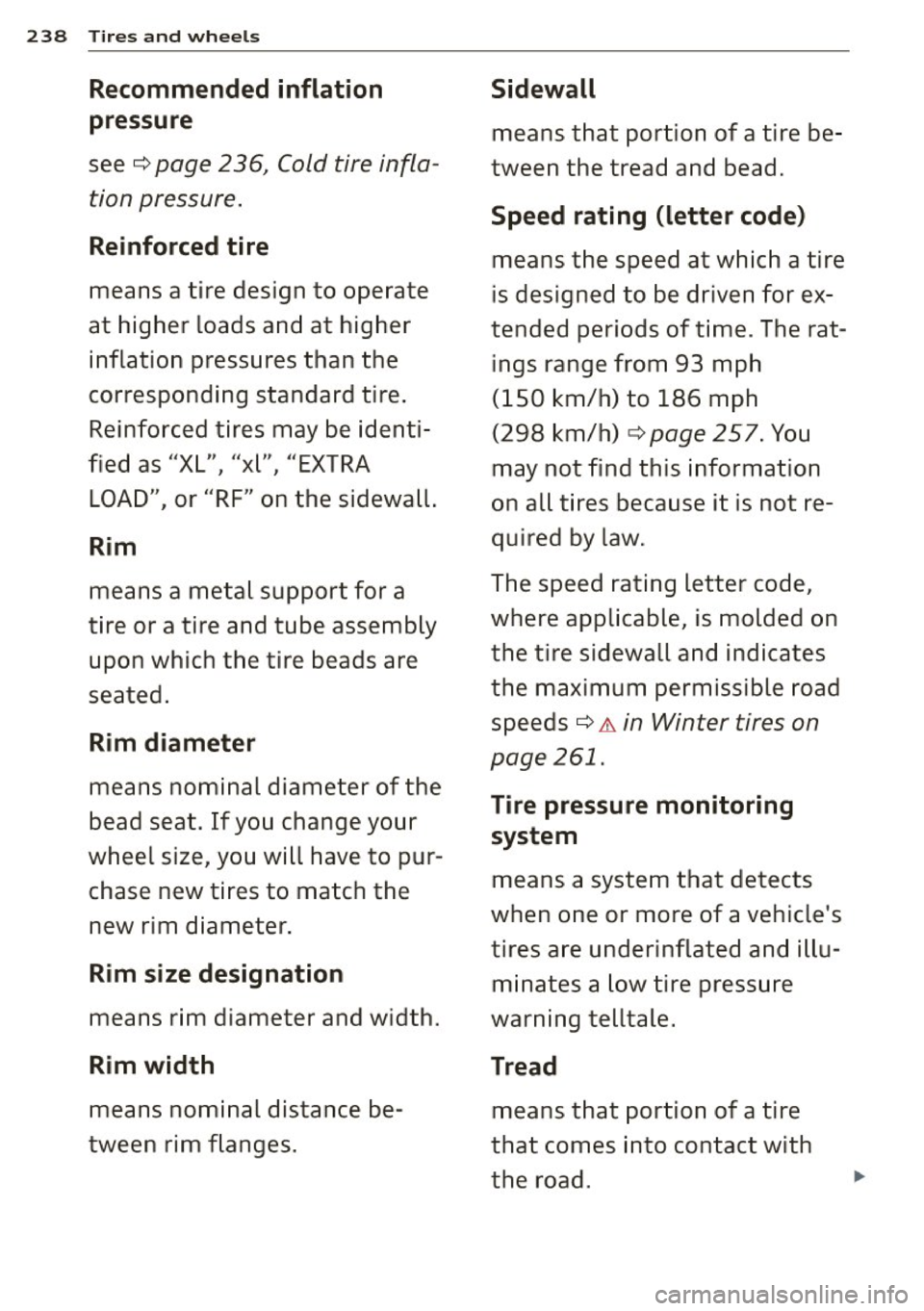
238 Tires a nd whee ls
Recommended inflation
pressure
see c:::> page 236, Cold tire infla
tion pressure.
Reinforced tire
means a tire design to operate
at higher loads and at higher
inflation pressures than the
corresponding standard t ire .
Reinforced tires may be identi
fied as "XL", "xl", "EXTRA
LOAD", or "RF" on the sidewa ll.
Rim
means a meta l support for a
tire or a tire and tube assembly
upon which the tire beads are
seated .
Rim diameter
means nominal diameter of the
bead seat. If yo u change your
wheel size, you will have to pur
chase new t ires to ma tch the
new rim d iameter .
Rim size designation
means rim diameter and width.
Rim width
means nominal distance be
tween rim flanges.
Sidewall
means that por tion of a tire be
tween the tread and bead.
Speed rating (letter code)
means the speed at wh ich a tire
is designed to be driven for ex
tended periods of time . The rat
ings range from 93 mph
( 1 50 km/h) to 186 mph
( 2 98 km/h)
c:::> page 257 . You
may not find th is informat ion
on all tires because it is not re
quired by law.
The speed rating letter code,
where applicable, is molded on
the ti re sidewall and ind icates
the maximum permissible road
speeds
c:::> & in Winter tires on
page 261.
Tire pressure monitoring
system
means a system that detects
when one or more of a vehic le's
tires a re underinflated an d ill u
m inates a low tire press ure
warn ing telltale.
Tread
means that por tion of a tire
that comes into contact with
the road.